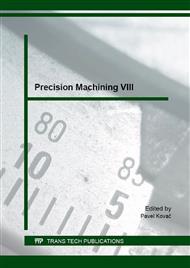[1]
J. Belak, and I.F. Stowers, A molecular dynamics model of the orthogonal cutting process, Proceedings of the American Society of Precision Engineering (1990) 76-79.
Google Scholar
[2]
J. Belak, and I.F. Stowers, The indentation and scratching of a metal surface: A molecular dynamics study, Fundamentals of Friction: Macroscopic and Microscopic, Singer, Pollock E, 220 (1991) 1-10.
DOI: 10.1007/978-94-011-2811-7_25
Google Scholar
[3]
R. Rentsch and I. Inasaki, Molecular dynamics simulation for abrasive processes, Annals of the CIRP 43 (1) (1994) 327-330.
DOI: 10.1016/s0007-8506(07)62224-0
Google Scholar
[4]
R. Rentsch and I. Inasaki, Effects of fluids on the surface generation in material removal processes, Annals of the CIRP 55 (1) (2006) 1-4.
DOI: 10.1016/s0007-8506(07)60492-2
Google Scholar
[5]
R. Komanduri, N. Chandrasekaran and L.M. Raff, Some aspects of machining with negative-rake tools simulating grinding: A molecular dynamics simulation approach, Philosophical Magazine Part B 79 (7) (1999) 955-968.
DOI: 10.1080/13642819908214852
Google Scholar
[6]
Y. Ye, R. Biswas, J.R. Morris, A. Bastawros, and A. Chandra, Simulation of nanoscale polishing of copper with molecular dynamics, Mat. Res. Soc. Symp. Proceedings 732E (2002) I4. 8. 1-6.
DOI: 10.1557/proc-732-i4.8
Google Scholar
[7]
B. Lin, S.Y. Yu and S.X. Wang, An experimental study on molecular dynamics simulation in nanometer grinding, Journal of Materials Processing Technology 138 (2003) 484-488.
DOI: 10.1016/s0924-0136(03)00124-9
Google Scholar
[8]
Q. X. Pei., C. Lu, F.Z. Fang and H. Wu, Nanometric cutting of copper: A molecular dynamics study, Comp. Mat. Sci. 37 (2006) 434-441.
DOI: 10.1016/j.commatsci.2005.10.006
Google Scholar
[9]
R. Promyoo, H. El-Mounayri and X. Yang, Molecular dynamics simulation of nanometric machining under realistic cutting conditions, Proceedings of ASME International Conference on Manufacturing Science and Engineering (MSEC2008) October 7-10 (2008).
DOI: 10.1115/msec_icmp2008-72533
Google Scholar
[10]
A. Oluwajobi and X. Chen, The fundamentals of modelling abrasive machining using molecular dynamics, International Journal of Abrasive Technology 3 (4) (2010) 354-381.
DOI: 10.1504/ijat.2010.036967
Google Scholar
[11]
A. O. Oluwajobi and X. Chen, The effect of interatomic potentials on the molecular dynamics simulation of nanometric machining, Int. J. of Automation and Computing 8 (3) (2011) 326-332.
DOI: 10.1007/s11633-011-0588-y
Google Scholar
[12]
M. Cai, X. Li and M. Rahman, Molecular dynamics modelling and simulation of nanoscale ductile cutting of silicon, International Journal of Computer Applications in Technology 28 (1) (2007) 2-8.
DOI: 10.1504/ijcat.2007.012325
Google Scholar
[13]
Y. Guo, Y, Liang, M. Chen, Q. Bai and L. Lu, Molecular dynamics simulations of thermal effects in nanometric cutting process, Science China Technological Sciences 53 (3) (2010) 870-874.
DOI: 10.1007/s11431-009-0243-9
Google Scholar
[14]
W.C.D. Cheong, L. Zhang and H. Tanaka, Some essentials of simulating nano-surface processes using the molecular dynamics method, Key Eng. Materials 196 (2001) 31-42.
DOI: 10.4028/www.scientific.net/kem.196.31
Google Scholar
[15]
Z. -C. Lin, Z. -D. Chen and J. -C. Huang, Establishment of a cutting force model and study of the stress-strain distribution in nano-scale copper material orthogonal cutting, International Journal of Advanced Manufacturing Technology 33 (5-6) (2007).
DOI: 10.1007/s00170-006-0480-z
Google Scholar
[16]
Hwang H.J., O-K Kwon and J. W. Kang, Copper nanocluster diffusion in carbon nanotube, Solid St. Comm. 129 (2004) 687-690.
DOI: 10.1016/j.ssc.2003.12.033
Google Scholar
[17]
L.A. Girifalco and V.G. Weizer, Application of the Morse potential function to cubic metals, Phys. Rev. 114 (1959) 687-690.
DOI: 10.1103/physrev.114.687
Google Scholar
[18]
J. Tersoff, Empirical interatomic potential for silicon with improved elastic properties, Physical Review B 38 (14) (1988) 9902-9905.
DOI: 10.1103/physrevb.38.9902
Google Scholar
[19]
H. Raffi-Tabar and G.A. Mansoori, Interatomic potential models for nanostructures in: H.S. Nalwa (ed. ), Encyclopedia of Nanoscience and Nanotechnology, American Scientific Publishers, X, 2003, pp.1-17.
Google Scholar
[20]
S.J. Plimpton, Fast parallel algorithms for short-range molecular dynamics, Journal Comp. Phys. 117 (1995) 1- 19 and www. lammps. sandia. gov.
Google Scholar
[21]
Visual Molecular Dynamics (VMD), http: /www. ks. uiuc. edu/Research/vmd.
Google Scholar


